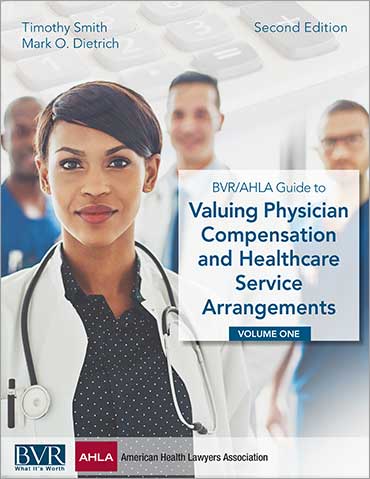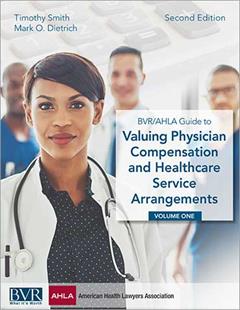BVR/AHLA Guide to Valuing Physician Compensation and Healthcare Service Arrangements, Second Edition
October 2017 Hardcover, PDF (1,400 pages)
Mark Dietrich, Timothy Smith
Business Valuation Resources, LLC
The new BVR/AHLA Guide to Valuing Physician Compensation and Healthcare Service Arrangements, Second Edition challenges and deconstructs the industry’s current standard for the fair market value (FMV) of physician clinical compensation based on the exclusive use of survey data and certain percentile-based valuation methods. It debunks the current “survey says” paradigm and provides the foundation for a completely new standard for the FMV of physician clinical compensation through an in-depth and systematic presentation of the theory and practice of healthcare compensation valuation.
The guide walks you through an extensive analysis of the data and ultimately concludes that “survey says” is not what the surveys say. In fact, the survey data present a completely different picture of physician compensation than envisioned under the industry’s current model. Moreover, the guide sets the record straight on the government’s views of survey data and FMV, highlighting the industry’s misunderstanding of regulatory guidance and enforcement actions. Further, the guide presents analyses which indicate that the current approach to FMV undermines the industry’s move from volume to value.
In response to the collapse of the “survey says” paradigm for FMV, this guide presents the new standard for valuing physician clinical compensation based on the new RBRVS method and adaptation of the industry’s standard independent investor test, along with appropriate use of survey data for industry benchmarking. This new approach replaces the current paradigm with the most defensible approach to FMV and commercial reasonableness (CR) based on sound valuation methodology, rigorous data analytics, and an understanding of regulatory guidance on FMV and CR in light of the enforcement record.
Ensure that you are using the most defensible methods, techniques, and information sources in your valuation of physician compensation. This two-volume, 1,400 page treatise is organized into 10 sections to provide you with quick and easy analytical tools for evaluating and assessing compensation arrangements. See table of contents
Additional Product Details:
Highlights of the Guide include:
- Tap into the expertise of some of the top thought leaders in healthcare compensation valuation – the 42 contributing authors range from a wide cross-section of valuation, consulting, and law firms, including an international perspective
- Access a wealth of thoroughly vetted, critically-reviewed, and evidence-based materials and professional literature – the ideas, concepts, methods, and conclusions in each chapter were subject to rigorous editorial review standards
- Get the latest theory in healthcare compensation valuation with a broad and comprehensive perspective on this complex topic. This edition is comprised of 83 chapters with almost all updated and new material, including:
- Thirteen chapters on the appropriate use of physician compensation survey data, including in-depth data analysis, regulatory and enforcement considerations, and practical applications
- New chapters on the issue of practice losses and physician compensation
- Ten chapters on valuing physician clinical compensation including the latest valuation methods and techniques
- New content on FMV and commercial reasonableness issues in enforcement cases and actions
- A new section with four key chapters which address the move from volume to value and its impact on physician compensation
- An updated and expanded section on commercial reasonableness
- New and practical chapters on valuing call coverage arrangements, focused on valuation methods and techniques
- New chapters on specialized topics such as telemedicine, hospital-based coverage arrangements, physician supervision of APPs, the Sunshine Act, Stark compliance for compensation plans, and physician compensation plan design
- An in-depth look at the government’s FMV case in Tuomey and Halifax
- New chapters on international compensation valuation
Table of Contents
VOLUME ONE
An Introduction to the BVR/AHLA Guide to Valuing Physician Compensation and Healthcare Service Arrangements
Part I. Introduction to Healthcare Compensation Valuation
- Chapter 1. An Introduction to the New Appraisal Discipline of Compensation Valuation
- Chapter 2. Using Standard Appraisal Methodology in Compensation Valuation
- Chapter 3. Defining the Market Approach in Compensation Valuation
- Chapter 4. On the Informed Use of the Market Data in Compensation Valuation
- Chapter 5. Defining the Cost Approach in Compensation Valuation
- Chapter 6. Defining the Income Approach in Compensation Valuation
- Chapter 7. Using Multiple Approaches and Methods as a Prudent Practice in Compensation Valuation
- Chapter 8. Elements of a Compensation Valuation Appraisal Report
Part II. Regulatory Matters in Compensation Valuation FMV Under Federal Healthcare Regulations
- Chapter 9. The Federal Statutes That Make Healthcare Valuation Unique
- Chapter 10. How Federal Healthcare Regulations Define FMV and Appraisal Methodology
- Chapter 11. Analyzing the Regulatory Prohibition on the Use of Market Data From Parties in a Position to Refer
- Chapter 12. Reconciling FMV for Healthcare Regulatory Compliance With Standard Appraisal Methodology
- Chapter 13. Tax-Exempt Organizations: Reasonable Compensation as Fair Market Value for Services
- Chapter 14. Reasonable Compensation for Physicians Under the Internal Revenue Code
- Chapter 15. Tax Regulations Affecting Tax-Exempt Healthcare Entities: An Introduction for Valuation Practice
- Chapter 16. BV, CV, and the Relationship Between Fair Market Value and Commercial Reasonableness
- Chapter 17. Commercial Reasonableness: Defining Practical Concepts and Determining Compliance in Healthcare Transactions for Physician Services
- Chapter 18. The Commercial Reasonableness Conundrum: Hospital-Physician Employment Arrangements, Expert Testimony, and the Little Standard That (Sometimes) Wasn’t There
- Chapter 19. ‘Commercial Reasonableness’ and Its Variable Meanings Under the Stark Law
- Chapter 20. The Threshold of Commercial Reasonableness
- Chapter 21. Practice Losses and Enforcement Risk: The Views of DOJ, Courts, Qui Tam Relators, and the IRS
- Chapter 22. Mitigating Stark and Kickback Liability Based on a Practice Losses Theory of Liability Is More Than Simply a Matter of ‘Survey Says’
- Chapter 23. Ensuring Healthcare Governance Processes Support Compensation-Focused Compliance
- Chapter 24. Strategies for Documenting Compliance With Stark’s Volume or Value Standard
- Chapter 25. By the Numbers: A Case-Based Understanding of Healthcare Valuation Fraud
Part III. Appropriate Usage of Survey Data in Valuing Physician Compensation
- Chapter 26. On the Use and Misuse of Survey Data: An Interview With MGMA
- Chapter 27. The ‘Survey Says’ Paradigm Is Not What the Surveys Say: How MGMA Data Disproves Popular Survey-Based Valuation Methods
- Chapter 28. Data Error: How the Healthcare Industry Misuses and Abuses Survey Data
- Chapter 29. The Majority of Experienced New-Hire Physicians Make Less Than the National Median: An Analysis of New-Hire Compensation in the MGMA and AMGA Data
- Chapter 30. wRVUs Don’t Explain or Predict 60% to 70% of Total Physician Compensation Outcomes in the Data: Findings From Regression Analysis of MGMA’s Data Set
- Chapter 31. A Study of MGMA’s Compensation by Quartile of Production Data: Wide Ranges of Compensation Are Observed at All Levels of wRVU Production
- Chapter 32. A Study of MGMA’s Compensation by Quartile of Production Data: Wide Ranges of Compensation Are Observed at All Levels of wRVU Production
- Chapter 33. Comparing the Surveys to the U.S. Physician Population: Implications for Valuation Analysis
- Chapter 34. The Feds Made Me Do It: Examining the Exclusive Use of Physician Survey Data for Stark Compliance Based on Regulatory Commentary and Enforcement Cases
- Chapter 35. Setting the Record Straight: Assessing What the Government’s Valuation Expert Actually Opined in the Tuomey and Halifax Cases Chapter Introduction
- Chapter 36. How ‘Calculated’ (Along With ‘Reported’) Compensation Per wRVU Amounts Can Help Assess Fair Market Value Compensation
- Chapter 37. Choosing the Best Survey for a Physician Compensation Market Study
PART IV: Key Topics inthe Economics and Valuation of Physician Services
- Chapter 38. An Introduction to Physician Services and Specialties
- Chapter 39. The Economics of Physician Clinical Services and Compensation
- Chapter 41. Evaluating RVU-Based Compensation Arrangements
- Chapter 42. How Local-Market Payer Rates Impact Physician Compensation: A Study of Key Markets in the U.S.
- Chapter 43. How Local-Market Payer Rates Impact Physician Compensation: A Study of Midwestern Markets
- Chapter 44. Analyzing the Economics of Losses in Health System Physician Practices: Why They Occur and Why They Matter for Regulatory Risk
- Chapter 45. Physician Practice Losses and Commercial Reasonableness: The Math of It
- Chapter 46. An Overview of Physician Reimbursement
- Chapter 47. The Denominator Impact: An Examination of Work Hour Assumptions Used in Computing Hourly Physician Pay Rates
- Chapter 48. Physician Integration Strategies and Implications for Compensation Design
VOLUME TWO
Part V. Valuing Specialized Physician Services and Other Arrangements
- Chapter 49. Valuing Hospital-Based Physician Coverage Arrangements
- Chapter 50. An Introduction to Valuing Telemedicine
- Chapter 51. Compensation Models for Physicians Working With Advanced Practice Providers
- Chapter 52. Valuing Physician Executive and Administrative Compensation
- Chapter 53. Valuing Physician Medical Directorships for Hospitals and Other Healthcare Facilities
- Chapter 54. Valuing Management Services Arrangements
- Chapter 55. On the Use of Physician Compensation Survey Data in Deriving Hourly Physician Pay Rates
Part VI. Valuing Services in the Life Sciences Sector
- Chapter 56. Life Sciences: Compensation Valuation in an Age of Transparency
- Chapter 57. Valuing Intellectual Property Licensing Arrangements Within the Life Sciences Industry
- Chapter 58. Shedding Light on the Physician Payments Sunshine Act— Considerations for Appraisers
Part VII. Valuing Call Coverage Arrangements
- Chapter 59. An Overview of Hospital Call Coverage Services
- Chapter 60. Contractual Terms and Structures for Hospital Call Coverage Arrangements
- Chapter 61. Regulatory Issues and Considerations for Call Coverage Arrangements
- Chapter 62. An Overview of Key Issues and Methods for Valuing Hospital Call Coverage Arrangements
- Chapter 63. The Challenges and Pitfalls in Using Market Survey Data to Value Hospital Call Coverage Arrangements
- Chapter 64. Valuing Physician Availability in Unrestricted Call Coverage Arrangements
- Chapter 65. Adjusting On-Call Availability Pay for Response and Rotation Requirements
- Chapter 66. Valuing Uncompensated Care in Unrestricted Call Coverage Arrangements
- Chapter 67. Adjusting On-Call Pay for Concurrent Call Arrangements
Part VIII. Valuing Physician Clinical Services
- Chapter 68. Valuing Physician Arrangements for Clinical Services: An Introduction
- Chapter 69. Three Paradigms and Three Approaches for Valuing Physician Clinical Services
- Chapter 70. Why the ‘Survey Says’ Paradigm Should No Longer Be Used to Value Physician Clinical Services
- Chapter 71. The New Market Approach: Using RBRVS to Value Physician Clinical Services
- Chapter 72. Using Work RVUs and ‘Particular Market’ Rates to Establish Fair Market Value Physician Compensation
- Chapter 73. An Introduction to the Use of Earnings-Based Compensation for Valuing Physician Clinical Services
- Chapter 74. Applying Earnings-Based Compensation in the Cost and Income Approaches
- Chapter 75. Addressing Ancillary and Other Provider Profit Streams in Applying Earnings-Based Compensation
- Chapter 76. Valuing Physician Clinical Services: Key Considerations in Developing a Conclusion of Value
- Chapter 77. Special Issues in Applying Value Conclusions to Physician Agreements for Clinical Services
Part IX. Valuing Physician Compensation in Value-Based Reimbursement Models
- Chapter 78. Valuation of Physician Compensation Under Alternative Payment Models Using the Market Approach: Pay-for-Performance, Shared Savings, Bundled Payments, and Global Budgets
- Chapter 79. Measuring Fair Market Value of Capital and Compensation With Performance-Based Revenue
- Chapter 80. Considering the Value of Clinical Co-Management Arrangements in Light of Emerging Value-Based Reimbursement Models
- Chapter 81. How Survey-Based Physician Compensation-Setting Practices Undermine the Move to Value-Based Compensation
Part X. International Perspectives on Healthcare Valuation
- Chapter 82. Healthcare Compensation and Valuation—An International Perspective
- Chapter 83. A New Valuation Technique for Measuring Consultants Quality in Financial Terms: The U.K. Experience
About the Authors
Index

